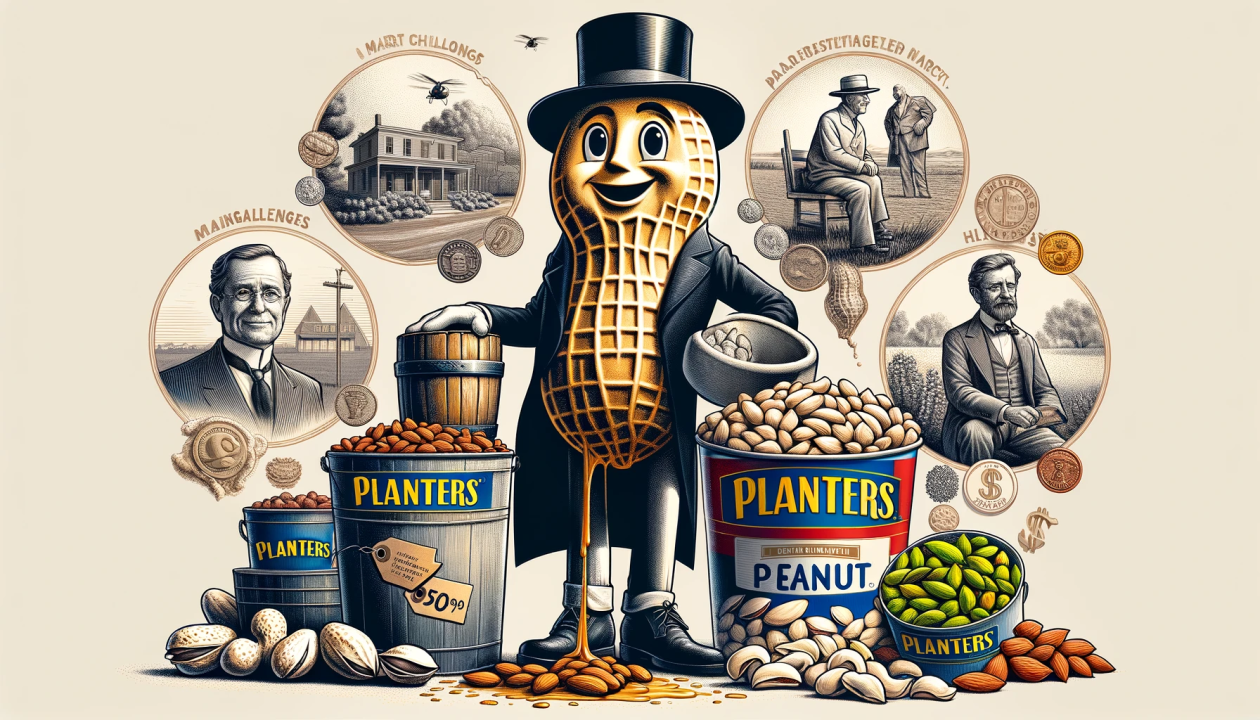
"Cracking the Shell: The Rise, Struggle, and Revival Strategies of Planters' Mr. Peanut"
Background:
When The Planters Company first began selling in 1906, it sold one kind of nut which was also considered a legume. The company aimed to become the "national nut" by producing low-cost, high-quality peanuts. In 1916, the company debuted a one-of-a-kind logo known as "Mr. Peanut." The slogan "social rise of peanuts" was adopted nationwide, complete with a monocle cane, gloves, and a top hat. Because of the tagline, ad campaigns aimed at young people in the United States were a huge success. It had been a long-running marketing strategy for the company. Mr. Peanut was marketed as an excellent addition to garden picnics, main courses, desserts, and baseball games. Mr. Peanut was involved in sports, entertainment, comedy, action, imagination, and advertising, so their commercial campaign captivated a large number of people.
Product focus:
Planters' brand and logo Mr. Peanut was the first of its kind, making it difficult for competitors to imitate without infringing on their intellectual property. Furthermore, its ambition of becoming the "national nut" at a low price made it popular among the people, pushing away its competitors.
Planters began with one type and eventually expanded into others like pistachios, cashew nuts, mixed nuts, and almonds to provide customers with a variety of options.
Mr. Peanut focused mostly on peanuts, as compared to competitors who focused more on other sorts, such as pistachios, resulting in lower sales volume. The company had grown to be the largest in the nuts brand, and it worked with Kraft Food.
In 2012, the company lost its strong position in the industry. Despite the company's strong brand image, its product messaging was unable to compete with its market share.
Competitors
Store Brand, Blue Diamond, Wonderful, and Emerald are Planters Nuts' main competitors. Planters Nuts lagged its competitors in the selling of almonds and pistachios, with market shares of 2% and 4%, respectively.
Wonderful leads in the sale of pistachios with a market share of 69 percent, while Blue Diamond leads in the sale of almonds with a market share of 47 percent.
The lack of variety in the pistachio and almond brands, as well as other brands, contributed to a drop in sales volume. The market price of nuts has been extremely variable. Customers' demands for Planters Nuts shifted as a result of the company's competitors charging substantially cheaper pricing, particularly in the "leaky bucket" category.
The competitors entered the market by selling high-quality products in the "leaky bucket" category.
Customers shifted to competitors with higher quality. Planters Nuts' product message was less effective when compared to competitors, resulting in a customer shift. In general, client demand and concentration in the peanut business were on the decline.
The total demand for the Planters Nut industry, in particular, has decreased. Over the last six years, the overall demand, as measured by consumer penetration, has decreased from 46 percent to 38 percent. The decline in consumer penetration resulted in a loss in the company's market share in the "leaky bucket."
Market decline & planters poor promotion efforts
Popular varieties of nuts have changed, peanuts in the overall decline in the share of the nut market, people are increasingly inclined to eat those “healthier” nuts, such as almonds and pistachios.
Over 65 people consume the most nuts, 18-24 years old consumers consume the least. In a gendered study, women consumed more nuts than men and tended to eat almonds and pistachios, while men began to consume fewer nuts than women and tended to eat peanuts and cashews in total.
Planters’ brand impression is old, expensive, approachable, and highly associated with peanuts. And the brand is positioned and advertised to men aged 35-65, which has led to the loss of the following customer groups: people over 65, women, and health lovers. Only one major customer group was captured: 35-65 males, who love to eat peanuts or cashew nuts.
Lack of cooperation with associations
Blue Diamond received $20.5 million in sponsorship.
Wonder was sponsored for $9 million by Pistachio Growers of America
Whereas growers received only $4 million in grower advertising from the National Peanut Board.
Price
Customers who buy nuts are a price-sensitive demographic. Planter Nuts sells peanuts for $3.69 and cashews for $8.44, both of which are more expensive than major competing brands and supermarket brands.
Mixed Nuts costs $7.44, which is higher than leading competing brands but lower than store brands. Almonds and pistachios were priced at $6.16 and $7.36, respectively, which were cheaper than leading competitive brands and retail brands.
It can be observed that the price of Planters is really greater than that of rivals, which leads to a decrease in sales to some extent.
Market Perception
According to focus group results, the nutritional value of peanuts is comparable to that of almonds and pistachios, consumers often assume that the nutritional content of peanuts is significantly inferior to that of almonds or pistachios and are unwilling to utilize peanuts as a low-cost option.
Planters’ turnaround strategies
In efforts to research the state of the business, Magnesen and Mark gather the following:
Customer perceptions of nut types.
Actual nutrient content of nut types.
Brand awareness.
Brand Equity.
Qualitative research.
Focus groups.
Nut consumption demographic.
Impact on purchase intent.
In my opinion:
They had three issues: poor placement in new areas, a “leaky bucket” in existing markets, and deteriorating margins due to higher marketing costs in new regions. To be successful, Planters have to be utilized efficiently. The famous Mr. Peanut is recognized by almost 96% of Americans, and Planters are recognized by 71%. As the country's most branded nut, Planters has a 100-year history of loyal customers. Competitors may reclaim market share and revive demand for peanuts by exploiting its most valuable asset, brand recognition. The company should focus on fixing the “leaky bucket” and reviving Planters' primary product, peanuts, rather than investing resources in a market where it had no expertise.